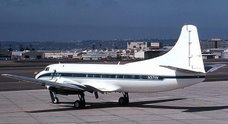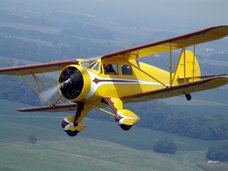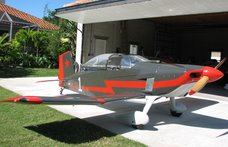Now the Fallout, a letter--one of several--from Ercoupe owners. It's reprinted here, unedited, in its entirety. You decide.
.
Dear Aviation Consumer News Editor,
I have been an avid reader of Aviation Consumer News since the early 1980's and rely upon your publication and the information it provides to the Aviation community. I've been very happy with the value provided.
However your recent article on the Legacy LSA's was very disappointing in several respects. The information presented regarding the Ercoupe was incomplete & inaccurate, a number of the Ercoupes significant advantages were downplayed or ignored, and several comments towards the Ercoupe were less than flattering if not outright derogatory, completely unnecessary, and misleading to Aviation Consumer readers.
Inaccuracies;(sic)
* The article states that the Ercoupe 415C is LSA eligible, but failed to mention or include the 415CD which is also LSA eligible.
* The article states that Ercoupes have no rudder pedals, which is not true. Some of the Ercoupe fleet already have rudder pedals, AND they're available as an option for those who must have them (a completely un-necessary option!).
* "Spin proof handling? Need we even offer an answer?" Yes, actually the Ercoupe is certified as spin proof!
* "One broke up in flight due to center section corrosion." Not true. In the case I am aware of some corrosion was found in the center section during the post crash investigation however; the official determination was that the Ercoupe appeared to have been stressed beyond design limits (loss of the tail section and flight control) prior to the failure of the wing center section failure (in a high negative loading mode, due to the prior loss of the tail), and the corrosion was not the cause of the failure. In this case the pilot was likely attempting a loop or other aerobatic type maneuver with two aboard however; regardless of the exact details what is clear is that the Ercoupe was being operated well beyond its design limitations. All Ercoupes should have had the wing spar and center sections inspected per prior AD's (sic). In any case a thorough pre-buy inspection should be done for corrosion on ANY & ALL legacy LSA types! Corrosion is NOT unique to the Ercoupe.
* "(....doing 95 MPH)" Most of the Ercoupes I know have been converted to 85 HP and even the 75 HP Coupes are generally capable of cruising at over 100 MPH - and typical cruise of 100 to 108 MPH.
* "These legacy LSA's are not terribly comfortable, and if you can't fly coordinated and learn to use your feet they'll be neither pleasant nor kind, especially on the runway." The Ercoupe flies coordinated automatically, and are relatively comfortable, particularly without the rudder pedals installed. One can move your legs around or cross them as desired for comfort on longer cross country trips (such as from CA to OSH).
Unnecessarily derogatory & misleading statements;
* "The flight experience is best described as quirky, especially in cross winds, it has no rudder pedals." The in-flight experience is fairly normal compared to a modern aircraft such as a Cherokee or Bonanza, and only 'quirky' when compared to older rudder dominant tail wheel aircraft with lots of adverse yaw. The landings could subjectively be described as quirky however; such a term ignores that the Ercoupe is very capable of handling stiff cross winds that would likely ground other light aircraft, and the beefy trailing link landing gear design makes it MUCH more forgiving on landing than the other types. The Ercoupe probably has the most predictable and comfortable landings and takeoffs of any light plane manufactured in significant numbers. In this it is much more like contemporary light aircraft than tail dragger LSAs.
* "The Ercoupe, top, is an acquired taste savored by owners who can do without rudder pedals. Crosswind landings are faith-based flying." Rudders are an option for those so inclined however; they are completely un-necessary in the Ercoupe. Crosswind landings are the Ercoupes forte, and for the proficient Ercoupe pilot are routine in conditions that ground all other light planes. They are "faith-based" in the sense that the pilot can have absolute faith the plane, if flown properly, will predictably do what is expected so long as the pilot knows the difference between luck and skill. I have landed my Ercoupe in 30 knot direct 90 degree cross winds and have witnesses (Paul Rosales of the SoCal RV group among them) and video to prove it, and others claim to have landed their Coupes in 40 knot cross winds. Try that in a tail wheel LSA. Here's a video link;
http://youtube.com/watch?v=4Ob7toBLP2I @ 5:40 into the video you can watch my Ercoupe land however; be sure to watch the other landing and listen to the Bellanca pilot during take off at the end. Perhaps you believe that an automatic transmission is an acquired taste savored by those who can do without shifting gears? Please also refer to the detailed note on this topic at the end of this letter.
* "Amazingly it will straighten itself out....the way a dead cow straightens out when dropped off a moving truck." PLEASE, would the author also use this term to describe a 707 or other transport or military jets using largely the same crab style landing technique?!?!? We can confidently assert that many superior aircraft have adopted the same system. Witness crosswind landings in virtually all large airliners and the Space Shuttle which all touchdown nose high, in a crab, just like an Ercoupe. I doubt that this kind of comment is what Aviation Consumer News readers expect from this publication.
* “We can't say we're crazy about this plane...." You don't say?! We'd never have guessed, and I would ask who is "we" in this case?
* "If you have lazy feet, the 75 HP Ercoupe 415C may be for you..." Or the 85 HP Ercoupe 415-C or 415-CD too. And this is true even if you don’t have lazy feet, but instead are cursed with more intelligence than ego.
* "Last pick is the Ercoupe. They aren't cheap and, in our view, lack the charm of the tail draggers which except for the cub, are all bargain for beginner or lingering pilots." First, I'd say that if this statement is true, then the market may be contradicting the author. However I'd also note that the figures given show the Ercoupe to be priced within about 10% of the other types, which seems quite reasonable given it's very unique features and key advantages. I'd also add that if we're talking beginners or infrequent flyers, the easy to land and easy ground handling Ercoupe may well be the better pick. For those who prefer tail wheel aircraft like the author, I understand that a 'conventional' type would be preferred. With higher cruise speeds and far fewer worries about cross winds, the Ercoupe is also a better pick for those who wish to actually go somewhere in their aircraft. BTW - There are those who would say that no one in their right mind would choose one of the tail wheel LSAs over an Ercoupe in good condition.)
Ercoupe advantages compared to other legacy LSA's;
* Tri-cycle gear for stable landing & ground handling.
* Superior cross wind landing capabilities (I'd be very happy to prove this claim)
* Good brakes (many if not most Ercoupes are now converted to Cleveland brakes)
* Stall resistant and spin proof (when properly rigged and flown within weight & balance limits)
* Responsive full span ailerons.
* Electrical system.
* Excellent visibility. This is a great safety feature for avoiding mid-air collisions at busy airports!
* Windows down "open cockpit" flying experience!
* Higher speed cruise than other LSAs with the same engine
* Mostly metal or all metal construction (only wings are fabric, and many have been metalized), resulting in generally lower costs (recovering a fabric plane is very costly).
* Very simple systems: no fuel tank switching and no flaps.
I would point out that there have been several recent articles in AOPA Pilot & EAA Sport Pilot about the Ercoupe which would be helpful as references, although even more detailed and accurate information about the Ercoupe is available.
Mr. Berge clearly favors the more traditional tail wheel Legacy LSA's, and the Champ in particular, which I noticed he owns. All this is fine and I will be the first to admit that the Champ is a worthy airplane. However in this article the content appears to have significantly reflected a personal bias of the author.
I expect evenhanded and accurate reporting from the Aviation Consumer and hope you will address the article's shortcomings, and / or print the relevant information for your readers.
Sincerely,Dan Hall
Ercoupe Owner Club Region 7 acting Director
1947 Ercoupe 415CD
N3968H @ CNO
(BS Aeronautics, PPSEL, CPSEL, Instrument rated, tail wheel, and 1,300+ hours in Ercoupes)
PS
With regard to cross wind landing it would be prudent to be aware of and perhaps even pass along the following information to AC's normally well informed readership;
The Ercoupe’s crosswind landings are engineering-based! Fred Weick, owner of the patent on the tricycle landing gear and later Chief of Design at Piper, carefully developed and extensively researched landing with the tricycle gear.
The landing gear is based upon the principal that the center of mass is in front of the (fixed and non-swiveling) main gear. Since the nose gear (like all tricycle gear planes) is free to turn, the side loads on the main gear introduce a turning force when the plane is landed in the crab. The nose wheel turns and offers no side-force so the plane simply turns to line up with the direction of motion – as designed by a superior engineer.
The side forces are not enormous. An egg in a saucer in the pilot’s lap will stay in the saucer.
This excellently designed landing system is a key to the Ercoupe’s ability to handle strong, direct crosswinds. Many Ercoupe owners enjoy taunting local flight schools by flying touch and goes when the crosswinds are strong on beautiful Saturdays. It’s fun, waving with a hand raised through the convertible canopy at the grounded students and CFIs as we do landings even with crosswind components greater than 25 knots.
 One can only imagine the horror...the horror that veteran PETA volunteer, Brent Taylor, experience when he discovered yet another Ercoupe mounted in dying duck pose atop this strip mall in the very heart of EAA country, Oshkosh, Wi. *
One can only imagine the horror...the horror that veteran PETA volunteer, Brent Taylor, experience when he discovered yet another Ercoupe mounted in dying duck pose atop this strip mall in the very heart of EAA country, Oshkosh, Wi. *





